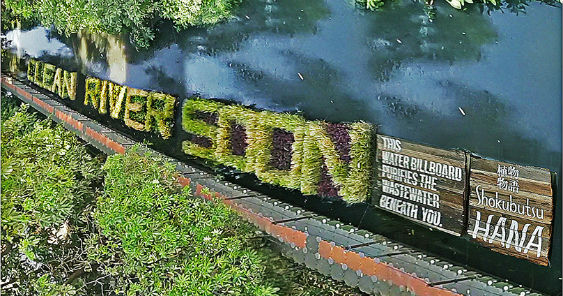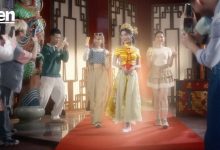MANILA – The Pasig River is one of the most polluted rivers in the Philippines. Over the years, environmental advocates, spearheaded by the Pasig River Rehabilitation Commission (PRRC), have tried to resuscitate this major body of water that flows through the heart of Manila.
So, to introduce what was then a new beauty brand–Shokobutsu Hana–that uses natural ingredients and advocates the protection of the environment, TBWA\Santiago Mangada Puno has decided to partner with PRRC to come up with a project that will not just create buzz for Hana but also to contribute to the rehabilitation efforts of the dying river, and spread the drowning call of the earth for help. The result–a first-of-its-kind floating billboard made up of water-purifying vetiver plants mounted on top of the river which spelled the plea “Clean River Soon,” and later on, “Purifying Now” and “Restoring River”.
Creative Directors Chino Jayme and Ali Silao talk to adobo magazine about how this project turned from an effort to introduce Hana into the beauty brand scene, and help clean the Pasig river into an award-winning idea that reaped metals across the international festivals like AdFest, D&AD, Clio, One Show, AD STARS and the coveted Cannes Lions.
Can you tell us about how this started?
Chino: This was our on-ground component for the Hana campaign actually. We had above-the-line and digital campaigns. Hana is an advocate of the preservation of nature so our campaign aimed to promote just that. Naturally, we looked for an area where we can spread the message so we thought that putting it on the river would be a good idea.
What was the original brief? What did Hana want?
Ali: Hana is about the distortive powers of nature. The advertising talks about that. So for this certain project since we already have the traditional advertising, we also decided to think of a disruptive medium to spread the message.
Was Hana a new product when you did this campaign?
Chino: Yes. This was part of the new campaign. There was a fair amount of pressure to really get out there. That’s why putting it at a disruptive medium is one way to attract attention for the brand and for the good message we want to put out as well.
Apart from Hana, you’ve worked on a lot of pro-environment campaigns. Is this really the kind of projects that your agency prefers to work on?
Chino: TBWA has focused on creativity for humanity. We believe that by focusing our creative brand that way, we can actually resonate better with people. When we did the Hana campaign, we had this in mind. And if you put it along with our previous works, it fits our mantra.
How long did it take before the campaign materialized? Did the idea of the floating billboard seem impossible at first?
Ali: Yes, it was a bit hard. At first we needed to talk to Gina Lopez because she’s the president of PRRC. When she found out about the project, she really liked it and she asked us to talk to PRRC. So when we presented the idea, she said we can work on two of their estuaries in San Miguel and Santibanez.
After that, we had to research. We had to research what kind of plant could help clean the water so we came up with the vetiver. We talked to the vetiver queen, Ms. Noa Maranan. She was the one who provided the vetiver. Apparently, they use vetiver talaga to clean water in garbage dumps. Companies use it to filter out water in their sewages.
The agency thought that using it as the advertising itself is actually a good idea. Of course, we also had to talk to production designers, to the PRRC, a lot of permits happened.
Chino: It was really a collaboration. We really needed help from so many different people and so many different groups to make it happen.
What were the challenges that you faced while making the billboard? Did you have problems with the residents living along the river?
Ali: No, not all. The residents were actually volunteers for the rehabilitation of the river.
There were isolated cases though that we lost some plants because we were also experimenting with other than the vetiver for the first billboard.
I think the biggest hurdle here is finding out how to do it on the first billboard. How are we going to do it? How is this going to last? How about the maintenance? How does it really clean? Those were the things that we had to figure out.
Curious question, where did you mount the plants? Did you have to use plastic?
Chino: We had to study the structure very well. There was the problem of moving water and there was the problem of weather. Though we put it up during the non-rainy season, we’ll never know when a typhoon might hit.
Ali: The first billboard was made of bamboo pontoons. But later on we realized that PVC plastic pipes would be better kasi it would require less maintenance and it’s more sturdy. But of course we made sure it doesn’t contribute to the pollution! The entire process was monitored by the Vetiver Farmers of the Philippines. It was really a big collaboration with them when we were creating this.
Did the campaign generate the buzz that you hoped for?
Ali: It did! Actually it exceeded our expectations. Of course we wanted the environmental and NGO websites to pick it up. But even design websites featured the campaign, it was even selected as ad of the week by Creativity.com, and also appeared in Co-create. They were likening it to other campaigns abroad like the billboard that can generate water in Peru. We’re happy that our project is changing what advertising and marketing is.
Did you expect this project to win a string of awards including a Cannes Lion?
Chino: Every time we do a project, we don’t expect to win. We just hope for the best in terms of winning for our creative work. But we’re very happy that it did.
Are there future applications for the water billboard in other areas in the Philippines (or other countries)?
The campaign was given a seat in the Sustainable Brands Conference in London last year. Since then, other international brands have taken an interest in using vetiver. Same goes to many local manufacturing companies that produce wastewater as a byproduct.
This project was also a way to make NGOs and LGUs aware of how easy it is to play your role in bringing the river back to life.
The billboards may have cleaned parts, but certainly we need as much help we can get to revive the entire body of water. We hope that they join us on the mission.
This article was first published in the September-October 2015 issue of adobo magazine.









